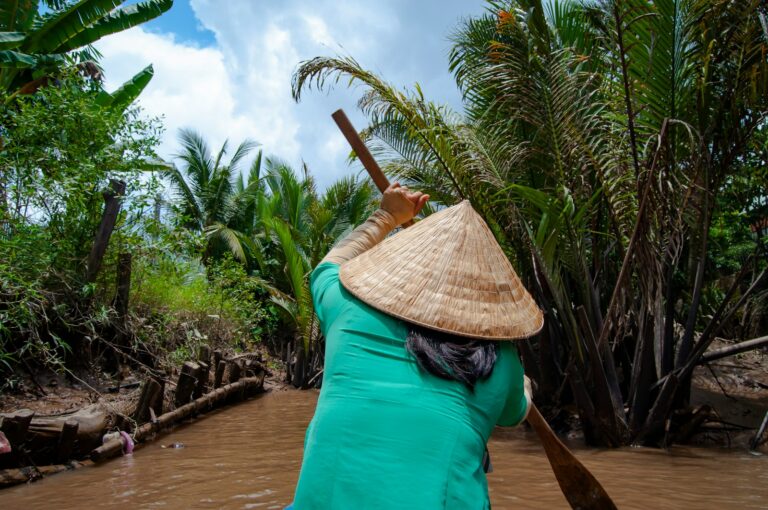Pearl Farming in Phu Quoc: The Jewel of the Sea
Phu Quoc, Vietnam’s largest island, is a place where the rhythm of the sea shapes both nature and livelihoods. Blessed with calm, nutrient-rich coastal waters, this island has quietly become a hub for one of the world’s most delicate industries: pearl farming. Thanks to advanced techniques imported from Australia and Japan, Phu Quoc’s pearl cultivation has flourished over the past two decades, blending ancient traditions with modern science.

The story began over 20 years ago with a pioneering joint venture between Australian and Vietnamese entrepreneurs. What started as a modest operation soon inspired local businesses to join the craft, including Quoc An Pearl Farm, one of the most established names today.
On my visit to Quoc An, sales representative Truong Hong Nhu explained how pearls—once the exclusive adornment of royalty—are carefully cultivated from tiny oysters to lustrous treasures. The process begins with the creation of a small nucleus, usually carved from the shell of an older oyster. Depending on the desired pearl shape, the nucleus is polished into a perfect sphere or fashioned into a teardrop.
Farmers then select oysters aged between six months and two years for implantation. After the tiny nucleus is inserted, the oysters are placed into mesh cages—about six oysters per cage—and submerged into the island’s pristine waters. Over the course of roughly two years, layer upon layer of nacre (the substance that gives pearls their iridescent glow) builds around the nucleus.
Maintaining the oysters is a labor of love. Workers must regularly dive to clean the shells, scraping off barnacles and other debris that could harm the oysters or diminish the quality of the pearls. Clean water and healthy oysters mean brighter, more luminous pearls—something the farmers take great pride in.
Pearls have long symbolized elegance and luxury. In ancient times, they were reserved for kings, queens, and nobles.
Today, pearls from Phu Quoc are crafted into necklaces, rings, earrings, and bracelets sought after by fashion lovers across the globe. Yet nothing from the oyster goes to waste. The shells are used in intricate wood inlays, fine buttons, and handmade crafts. The oyster meat itself is a local delicacy, and in traditional medicine, pearls are believed to aid detoxification, improve vision, and even strengthen bones and skin. Pearl powder is also widely used in cosmetics, particularly in brightening creams popular throughout Asia.
At Quoc An, the farm leases four hectares of ocean space dedicated solely to oyster cultivation. Technician Le Cong Thang explained how the system works: long ropes, stretching up to 800 meters, are anchored in the sea, holding dozens of oyster cages suspended beneath the surface. Floating houses serve as technical stations, where oyster “seeds”—often caught from the wild—are nurtured and acclimated before implantation.
Implantation is a meticulous process. To prepare the oyster, it is briefly exposed to air to reduce mucus, then carefully pried open. The technician inserts the nucleus into the reproductive organ, where it will trigger the formation of a pearl. But not all oysters accept the foreign body. Some expel it entirely, while others form deformed or misshapen pearls. Only a fraction—less than half—produce high-quality gems.
Pearls from Phu Quoc come in an array of natural colors: shimmering white, soft yellow, blush pink, and the coveted black. The larger the oyster, the more nuclei it can host—up to four in a single shell. But this comes at a cost: pearls with multiple nuclei tend to be less round, with thinner nacre and lower luster. Some may even develop odd shapes, known as “gourd pearls,” which have limited market value.
Smaller oysters, meanwhile, produce fewer but finer pearls. While most pearls are harvested within one to four years, some exceptional specimens remain underwater for up to 20 years, creating rare and precious gems of exceptional value.
The harvesting process is precise. Technicians carefully open each oyster along the hinge to extract the pearl without damaging it. The gems are then cleaned, polished, drilled, and graded according to shape, luster, size, and surface flaws. Only the finest pearls fetch top prices, often sold to luxury jewelers or high-end boutiques.
However, alongside genuine craftsmanship, there are challenges that threaten Phu Quoc’s pearl industry. The island’s bustling markets are filled with stalls selling bracelets, necklaces, and rings claiming to be “Phu Quoc pearls.” In reality, many are cheap imports from mainland Vietnam or even counterfeit pieces made from plastic or dyed shells. Without any formal certification authority in place, tourists and buyers often cannot tell the difference between authentic Phu Quoc pearls and fakes. This lack of regulation poses a risk to the island’s reputation as a center of quality pearl production.
Thang shared some simple tips to help spot genuine pearls. Rubbing two pearls together should create a soft, powdery residue that, when wiped, restores the pearl’s sheen. A gentle bite test reveals a slightly gritty texture, unlike the smoothness of plastic fakes. And while not practical for most shoppers, real pearls exposed to fire will turn red-hot and crumble, rather than melting like imitations.
To avoid disappointment, buyers are advised to purchase from reputable farms or certified sellers. At Quoc An, for example, each pearl comes with an authenticity certificate and even a 30% buyback guarantee for customers who change their minds—a rare policy in the jewelry trade.
Running a pearl farm is not without risks. Le Thi My Dung, the owner of Quoc An, revealed that their family-run business, established in 1995, employs more than 20 skilled technicians. Initial investments reached 7 to 8 billion VND (around $300,000), but losses can be high: up to 40% of oysters die before reaching maturity, and of those that survive, only a small portion produce pearls good enough for sale.
Despite these challenges, Phu Quoc’s pearl industry is looking toward a brighter future. The local government is beginning to consider measures to protect the authenticity of the island’s pearls, including the potential creation of a geographical indication (GI) label—similar to how Champagne or Parma ham is protected in Europe. Such certification would help preserve the value of Phu Quoc pearls and shield them from the flood of imitations.
Today, visitors to Phu Quoc can not only explore its beaches, forests, and vibrant night markets but also witness the delicate process of pearl cultivation firsthand. For those seeking a unique souvenir, a genuine Phu Quoc pearl carries with it the story of the sea, the patience of skilled hands, and the timeless beauty that only nature can create.
And as the island continues to grow as a premier tourist destination, the hope is that its pearl industry—rooted in tradition yet open to innovation—will shine just as brightly as the gems it produces.




